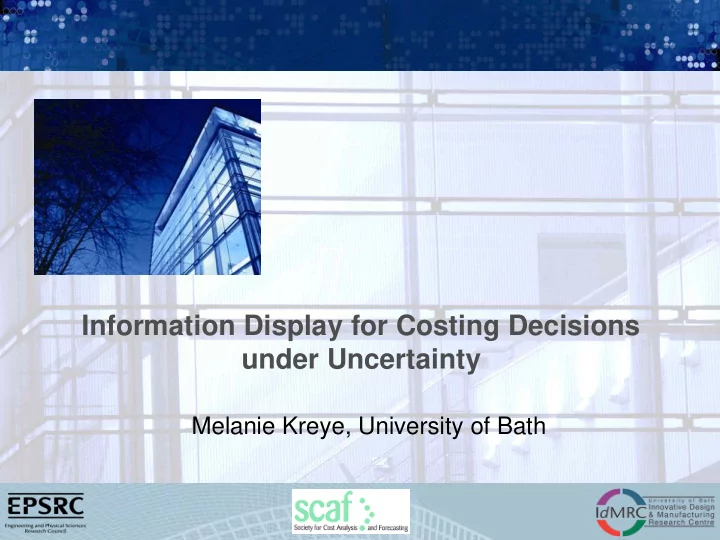

Information Display for Costing Decisions under Uncertainty Melanie Kreye, University of Bath
Outline 1) Introduction 2) Decision Making 3) Game Theory 4) Experimental work 5) Future Research Game Theory can be used to improve decision making in Through Life Cost estimating, where the costs and events are driven by a number of players
Introduction • Treatment of uncertainty in Through Life Costing (TLC) • Forecasting: estimation of a future value • Uncertainty can have different impacts on the forecast: – Design phase: from rough estimates to more elaborate forecasts – Forecasting span: systematically larger errors in longer forecasts • Methods for modelling uncertainty: Monte Carlo Analysis, sensitivity analysis
Decision Making • Decision Theory • What is a decision? – Big decisions as oppose to snap decisions – Final point or an action separating two periods – “making a choice of what to do and what not to do” (Tang 2006) – Commitment to an action serving interests of the decision maker • Differentiation between the decision and the decision making process
Decision Making • Divide the decision process into: – Decision problem – Uncertain events of Nature – Value of the outcomes • Outcome results from the act of the decision maker and a move of Nature e 1 a 1 e 2 e 1 a 2 e 2
Decision Making under Uncertainty • Models in Decision Theory: – Descriptive models – Normative models – Prescriptive models • Decision making in bidding stage • Game Theory can be used to improve decision making in Through Life Cost estimating, where the costs and events are driven by a number of players
Game Theory under Uncertainty • Game Theory provides theoretical underpinning for decision making • Decision problem is the “game” between two or more actors • Decision matrix: – Act of the decision maker – States of Nature – Consequences/payoffs
Game Theory under Uncertainty • Assumptions of Game Theory: – Individuals are instrumentally rational: expressible in constant preferences according to utility theory – Common knowledge of rationality – Common priors: same thought processes, same beliefs, use of the same information – Action within the rules of the game: every player knows the rules, every player’s motive is independent of the rules
Game Theory under Uncertainty • Assumptions of Game Theory: Individuals are instrumentally rational Common knowledge of rationality Common priors Action within the rules of the game
Game Theory under Uncertainty • How rational is a cost estimator? – Mental models – Uncertainty – Experience – Company – Information – Influence of memory – …
Experiment group A group B group C
Experiment • Participants: – Group A: 13 – Group B: 14 – Group C: 18 • Have you seen a diagram like this before? Group A Group B Group C
Experiment • The participants were asked: – to give an estimate for the future costs of a raw material for 2014, based on the information given – to give the reasons for their answer, which was phrased as an open question – to illustrate the confidence level for their own estimate – the same questions were asked for a 2018 estimate
Experiment - Results 50.00% 45.00% 40.00% 35.00% 30.00% questionnaire 1 25.00% questionnaire 2 20.00% 15.00% 10.00% 5.00% 0.00% conservative more information world economy uncertainty medium
Experiment - Results group A 50.00% 45.00% 40.00% 35.00% 30.00% questionnaire 1 25.00% questionnaire 2 20.00% 15.00% 10.00% 5.00% 0.00% conservative more information world economy uncertainty medium
Experiment - Results group B 50.00% 45.00% 40.00% 35.00% 30.00% questionnaire 1 25.00% questionnaire 2 20.00% 15.00% 10.00% 5.00% 0.00% conservative more information world economy uncertainty medium
Experiment - Results group C 50.00% 45.00% 40.00% 35.00% 30.00% questionnaire 1 25.00% questionnaire 2 20.00% 15.00% 10.00% 5.00% 0.00% conservative more information world economy uncertainty medium
Experiment - Results • Main results: – The different approaches of displaying the information can impact how it is perceived and interpreted. The FAN diagram made the participants most aware of the uncertainty involved in the forecast. – The participants were able to give their subjective evaluation of confidence associated with their estimate. – Point estimates were common. – The contextual information played an important role in forecasting in addition to the graphical information. – The contextual information made the participants more aware of uncertainty.
Future Research • Further experiments • Follow-up experiment planned – Introduce idea of bidding against an opponent into forecasting problem
Thank you for your attention. Questions and Feedback M.Kreye@Bath.ac.uk
Instrumentally rational • Allais paradox • All information is accessible to the decision maker and can be processed by him/her • Theory of bounded rationality: – Limited complexity of states ascertainable by an individual – Base decision on strategies and outcomes understandable and traceable for the decision maker – Individuals are able to learn, ie change their attitude/preferences according to stimuli
Recommend
More recommend